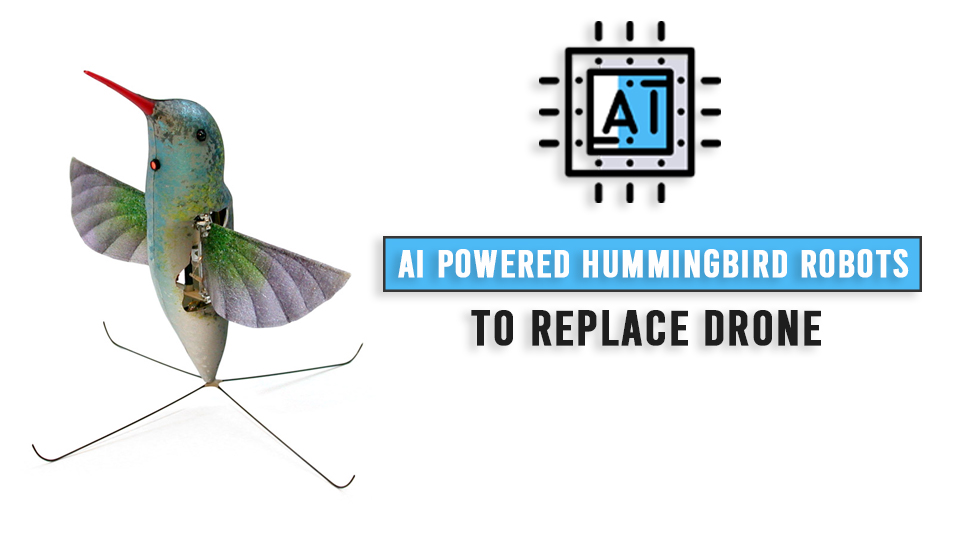
Isn’t it interesting to see hummingbirds acting like robots? If drones get this feature they can easily find out trapped victims by passing through collapsed buildings and other messed-up areas. Researchers are trying to engineer flying robots to act like hummingbirds. It will train these robots with machine learning AI algorithms on the basis of skills, natural birds use on a daily basis.
This implies that after studying from a simulation, the AI robot will know how to act on its own similar to a hummingbird. It will easily learn the techniques to pass through a difficult passage or perform a skilfull exercise.
How Drones will Perform like a Natural Bird?
AI-based flexible flapping wings teaches the robot newer tricks. Even if it is unable to see, it can sense through the touching surfaces. Each touch transforms into an electrical current, making it easier for the researchers to track.
The robot can even draw a map by not seeing its surrounding areas. This feature can prove beneficial when it is searching for a casualty in a no-light area. For the robot’s vision-ability, even one less sensor is used.
You cannot find drones smaller in size because of the conventional aerodynamics job. If the size is extremely small, then they will not be able to lift themselves in order to balance their weight.
However, to derive a look exactly like a hummingbird, using conventional aerodynamics is difficult but of course not impossible.
Experiments till Date on Hummingbird Drones
Researchers are tireless trying over a couple of years to decode hummingbird flight. In the year 2011, AeroVironment, which is a US Department of Defence agency built a hummingbird robot. These robots fly higher which was not possible for larger aircraft. It was heavier in weight than a real bird and was also not fast. In addition, it had flight controls just like a helicopter with restricted maneuverability. A human is required to control its remote always.
Engineers are also trying to bring a feature in these robots to take a rapid 180-degree turn when hooked up to a touch. This simulation is possible as the birds will learn from the translated computer algorithms.
Deeper study on the physics of hummingbirds permitted the engineers to create robot relatively smaller than hummingbirds. They also tried making robots even smaller than insects without compromising their way of flying. Also, the increased rate of wing flapping makes it fly more efficiently.
Also, the experts made robots with 3D prints, carbon-fiber wings, and membranes of laser-cut technology. Such advanced features made hummingbird robots which weigh 12 grams and one insect-sized robot of 1 gram in weight. The hummingbird robot has the ability to lift up to 27 grams of weight which is more than its weight.
Additional Features to Further Empower Hummingbird Robots in the Days to Come
Creating a robot with a higher lift allowed the researchers to add more options like a battery and sensor technology viz. a camera or a GPS. At present, these robots need to connect to a source of energy, say, for instance, fuel while flying but not for a longer duration.
Also, these robots can fly without making any sound, much like a real hummingbird. Thus, they are indeed perfect for undercover operations. They can also remain stable in the face of any disruption as they go through several testings by changing scaled wings in an oil tank. The robot needs 2 motors to control each separate wings to act in maneuvers.
A real hummingbird has more weight due to its muscles and flesh to perform various strokes. But a robot has to be lighter in weight to perform maximum actions. A robotic hummingbird will not only aid in rescue missions but also serve the biologists to learn and conduct research on the real hummingbirds through sensing the real robot. Biology has helped the researchers to build a robot and now robot will help biologists to yield greater benefits in biological discoveries.
Ending Note:
National Science Foundation gave financial support to the initial stages of this research in the Montana hummingbird experiments. Artificial Intelligence algorithms need to make robots perform automatically. These hummingbird robots must further be empowered with intellectual faculties so that they can operate automatically, i.e. without any human support.
